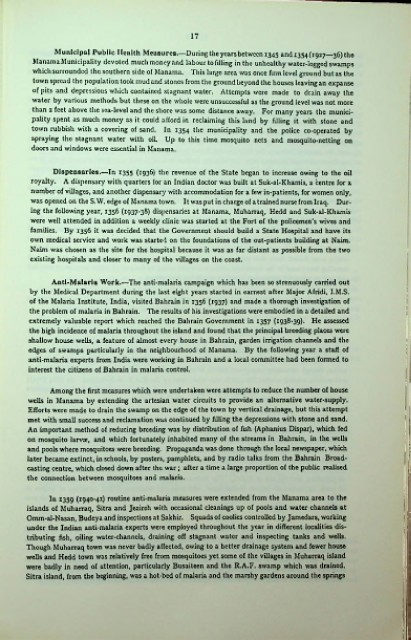Page 285 - Bahrain Gov Annual Reports (III)_Neat
P. 285
17
Municipal Public Health Measures.—During the years between 1345 and 1354 (1927—36) the
Manama Municipality devoted much money and labour to filling in the unhealthy water-logged swamps
which surrounded the southern side of Manama. This large area was once firm level ground but as the
town spread the population took mud and stones from the ground beyond the houses leaving an expanse
of pits and depressions which contained stagnant water. Attempts were made to drain away the
water by various methods but these on the whole were unsuccessful as the ground level was not more
than 2 feet above the sea-level and the shore was some distance away. For many years the munici
pality spent as much money as it could afford in reclaiming this land by filling it with stone and
town rubbish with a covering of sand. In 1354 the municipality and the police co-operated by
spraying the stagnant water with oil. Up to this time mosquito nets and mosquito-netting on
doors and windows were essential in Manama.
Dispensaries.—In 1355 (1936) the revenue of the State began to increase owing to the oil
royalty. A dispensary with quarters for-an Indian doctor was built at Suk-al-Khamis, a centre for a
number of villages, and another dispensary with accommodation for a few in-patients, for women only,
was opened on the S. W. edge of Manama town. It was put in charge of a trained nurse from Iraq. Dur
ing the following year, 1356 (1937-38) dispensaries at Manama, Muharraq, Hedd and Suk-al-Khamis
were well attended in addition a weekly clinic was started at the Fort of the policemen’s wives and
families. By 1356 it was decided that the Government should build a State Hospital and have its
own medical service and work was started on the foundations of the out-patients building at Naim.
Naim was chosen as the site for the hospital because it was as far distant as possible from the two
existing hospitals and closer to many of the villages on the coast.
Antl-Malarla Work.—The anti-malaria campaign which has been so strenuously carried out
by the Medical Department during the last eight years started in earnest after Major Afridi, I.M.S.
of the Malaria Institute, India, visited Bahrain in 1356 (1937) and made a thorough investigation of
the problem of malaria in Bahrain. The results of his investigations were embodied in a detailed and
extremely valuable report which reached the Bahrain Government in 1357 (1938-39). He assessed
the high incidence of malaria throughout the island and found that the principal breeding places were
shallow house wells, a feature of almost every house in Bahrain, garden irrigation channels and the
edges of swamps particularly in the neighbourhood of Manama. By the following year a staff of
anti-malaria experts from India were working in Bahrain and a local committee had been formed to
interest the citizens of Bahrain in malaria control.
Among the first measures which were undertaken were attempts to reduce the number of house
wells in Manama by extending the artesian water circuits to provide an alternative water-supply.
Efforts were made to drain the swamp on the edge of the town by vertical drainage, but this attempt t
met with small success and reclamation was continued by filling the depressions with stone and sand.
An important method of reducing breeding was by distribution of fish (Aphanius Dispar), which fed
on mosquito larva;, and which fortunately inhabited many of the streams in Bahrain, in the wells
and pools where mosquitoes were breeding. Propaganda was done through the local newspaper, which
later became extinct, in schools, by posters, pamphlets, and by radio talks from the Bahrain Broad
casting centre, which closed down after the war; after a time a large proportion of the public realised
the connection between mosquitoes and malaria.
In 1359 (1940-41) routine anti-malaria measures were extended from the Manama area to the
islands of Muharraq, Sitra and Jezireh with occasional cleanings up of pools and water channels at
Omm-al-Nasan, Budeya and inspections at Sakhir. Squads of coolies controlled by Jamedars, working
under the Indian anti-malaria experts were employed throughout the year in different localities dis
tributing fish, oiling water-channels, draining off stagnant water and inspecting tanks and wells.
Though Muharraq town was never badly affected, owing to a better drainage system and fewer house
wells and Hedd town was relatively free from mosquitoes yet some of the villages in Muharraq island
were badly in need of attention, particularly Busaiteen and the R.A.F. swamp which was drained.
Sitra island, from the beginning, was a hot-bed of malaria and the marshy gardens around the springs

